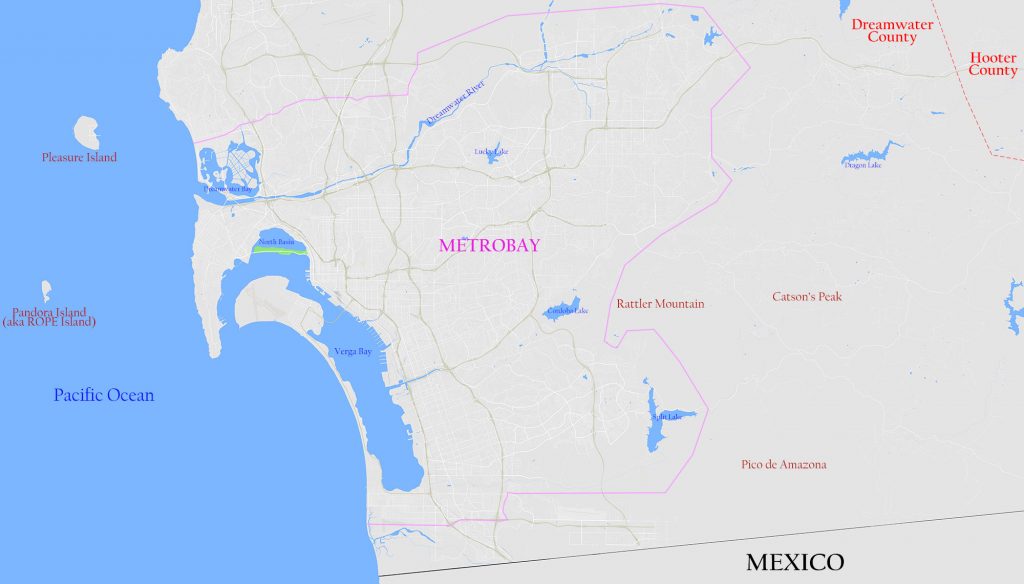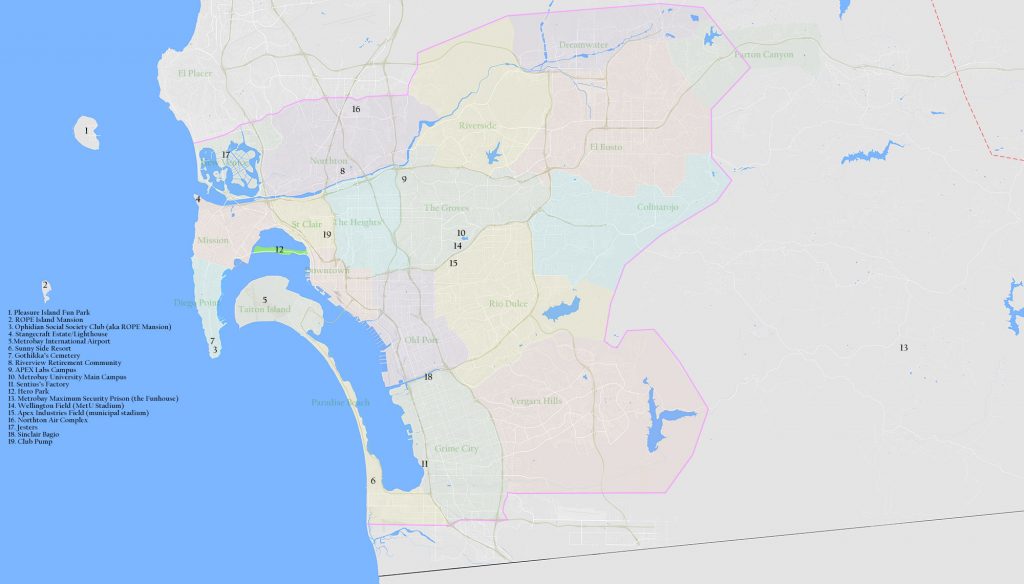 Metrobay is where it all takes place, a giant, sprawling urban center and major port into the country. Grime City is located near the harbor, across town from the business and residential districts.
Metrobay is where it all takes place, a giant, sprawling urban center and major port into the country. Grime City is located near the harbor, across town from the business and residential districts.
On a private island a couple of miles offshore sits R.O.P.E. Mansion, accessible only to members via their private yachts. There they scheme to rule the city as a haven for the aristocracy, where the filthy rich play God with the lives of those less fortunate.

DISTRICTS
Like all major metropolitan areas, Metrobay has a variety of neighborhoods and districts, all with their own unique flavors.

Colinarojo: “Red Hill” is a mostly rural area with small farms and a low population density.
Diego Point: Formerly occupied by military fortifications to protect the bay, has been gentrified into an upper-class area. Many ROPE members maintain residences here.
Downtown: main commercial, entertainment and administrative section. Some high-rise residential. Basically your typical major North American city high-density skyscraper area.
Dreamwater: Located along both banks of the Dreamwater River. The area is home to several noted vineyards.
El Busto: Formerly a Spanish-speaking town located outside the original Metrobay city limits, it was absorbed by the larger city in the 1950s. It currently is home to many of Metrobay’s heavy industries that have left Grime City.
El Placer: A bedroom community outside of Metrobay city limits, the small city has become an option for Metrobay residents looking for a bit quieter place to live.
Grime City: The main port and industrial section of the city, the area has suffered from middle class flight and has the highest crime rates in the region. If there’s an abandoned factory or warehouse, it’s probably in this area.
The Groves: Location of Metrobay University, minor colleges, museums, and the center of scientific research in Metrobay. Outside the research and educational facilities, mostly medium-density housing.
The Heights: Traditional area for the old money upper class of the city. Artistic scene, avant-garde clubs and restaurants. Max and Vivian Indeks live in this area.
Mission: Mostly residential and minor commercial area.
New Venice: A sterling example of what happens when one man has too much money and too little sense, multimillionaire Willard Echs made his fortune in cattle, and then rail, and while on a trip to Italy fell in love with the city of Venice and went a little bit mad (rumors that it was due to a chronic syphilis infection have never been proven). Echs returned to America and devoted his fortune to creating an American version of the Italian city, choosing the Dreamwater River delta and Dreamwater Bay as the location of his new city. New Venice eventually became successful in the 1920s when the bay and its many canals proved a boon for smugglers during Prohibition while the authorities focused most of their attention on the main port in Verga Bay.
New Venice became home to most of the area’s criminal underworld bosses and their families. It has since become the center of the tourism industry in the area, and its casinos and underground brothels still serve their select clientele.
Northton: Another community absorbed by Metrobay in the 1950s, the former city has retained its individual identity and many residents refuse to admit that they’re part of the larger city. The city’s economy formerly revolved around an Air Force base which closed in the 1990s. The former airbase was bought by a commercial group and repurposed into an air cargo hub and airline test facility.
Old Port: A mixed industrial/commercial/residential area. The residential section has been undergoing gentrification.
Paradise Beach: Mostly commercial are servicing the tourist industry. Known for surfing by day, partying at the many clubs along the beach at night.
Parton Canyon: Rural area just outside the city limits. The main claim to fame is this was the location of the treatment plant which provided most of Metrobay’s drinking water and which was used in the experiment which resulted in Metrobay’s most noted features. On the women.
Rattler Mountain: At 12,500 feet, is one of the highest mountains in the state. Due to the unusual climate in this area, precipitation is abnormally high keeping the mountain’s peak covered in snow much of the year. As a result, there’s a ski resort on the mountain. The surrounding area is perhaps the wildest part of the city (in the wilderness sense). Rattler Mountain is also the site of archaeological finds of a very great age, indicating the possibility of an Atlantean or another civilization of similar antiquity having contact with the region in the very distant past.
Rio Dulce: The old barrio section of the city, the area has been the focus of extensive residential and commercial development. It has become the artistic and cultural center of the city, with a multicultural population. It’s also home to the local film and television industry.
Riverside: Suburban residential area. An urban-wild interface community, hiking, mountain biking and running the Gorge in rafts are popular.
St. Clair: A residential and commercial area, St. Clair is well known for the shopping malls and markets found in the area, as well as a thriving fashion district.
Taiton Island: Home of Metrobay International Airport, the area has a mix of residential, industrial and commercial neighborhoods.
Vergara Hills: Generally middle-class to upper-class residential area, the residents (and homes) becoming richer the further into the hills one travels.
POINTS OF INTEREST

